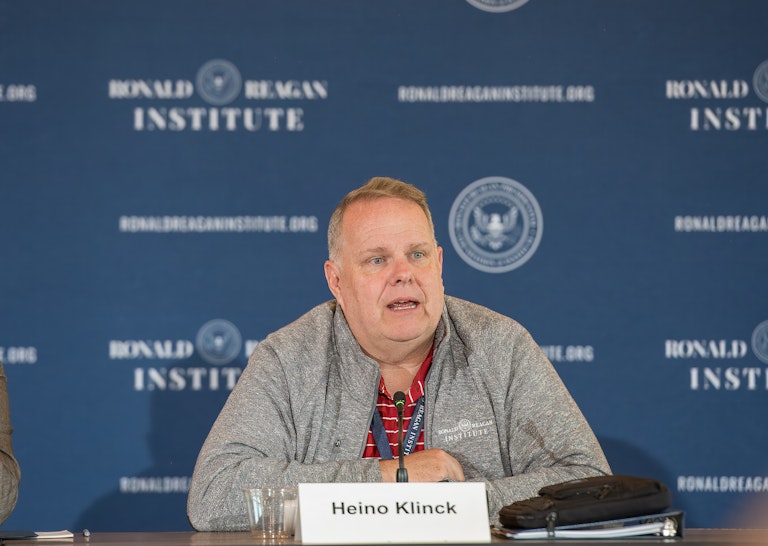Ronald Reagan Institute
The Cold War Paradigm is Inadequate for U.S.-China Strategic Competition
By Heino Klinck

The struggle between the United States and the Soviet Union, while historic and perilous, lacked many of the facets and dangers of the U.S.-China competition.1 The differences become clear when utilizing an updated analytical framework focused on the instruments of national power (commonly referred to as DIME-FIL).2
Diplomatic
A key distinction between the Cold War geopolitics and U.S.-China competition is the structure of international alignments. While an axis of authoritarianism and sympathies toward a so-called Beijing Consensus exists today, much of the world refuses to be overtly divided into a rigid ideological and geopolitical bloc.3 Many nations maintain cooperative relationships with both the United States and China, seeking to maximize benefits without fully aligning with either power. Countries engage with both superpowers without the strict binary choice that defined Cold War alliances. This makes the current international system much more fluid. In some circumstances, that favors the United States. However, given the Faustian bargain that many countries have made with China, there is significant risk as traditional allies and partners maybe less committed and reliable in their support of policies emanating from Washington.4
Informational
The Cold War was marked by stark information barriers: the Iron Curtain divided East and West, and propaganda wars were largely state-controlled. Today, the internet, multinational platforms, social media, and the ubiquitous, 24-hour flow of communications is an insidious characteristic of the Chinese Communist Party (CCP) battle against the United States and its values. the CCP has harnessed the power and mass of digital communications and social media for a constant barrage of propaganda, disinformation, and lies not only meant to disorient, but to shape international opinion and even U.S. domestic politics. China’s propaganda ecosystem has grown exponentially during the Xi Jinping era and is being unleashed both overtly and covertly in unprecedented ways that are difficult to stop or even impede.
Military
The military perils, particularly in the nuclear arena, that existed during the Cold War cannot be understated. Yet, we now know that in terms of defense technology and modern operating concepts the Warsaw Pact was no real match for NATO.5 In the Indo-Pacific, the correlation of forces favors China given the size and growing capabilities of the People’s Liberation Army (PLA).6 The tyranny of distance to the most likely theaters of conflict puts the United States at a considerable disadvantage.7 While important and relevant, America’s hub and spokes system of bilateral alliances is not on par with NATO and certainly not a guarantee of tangible military support in case of conflict with China.
Economic
The most conspicuous difference between the Cold War and U.S.-China competition is in the realm of economics and international commerce. The United States and the Soviet Union maintained largely separate economic systems.8 In contrast, the U.S. and China are deeply economically intertwined.9 Bilateral trade reached almost $600 billion in 2024, and the two countries are bound by complex supply chains, cross-border investment, technology links, and financial markets.10 This level of economic interdependence creates constraints that were absent during the Cold War, making outright economic decoupling difficult and economically risky for both sides. However, it also creates a dependency that China has exploited on countless occasions not only in the United States, but worldwide.
Finance
The Soviet Union and its allies were not significant international financial players. China most certainly is. It has amassed net foreign assets worth $4.3 trillion, making it the world’s biggest creditor.11 China recycled much of its foreign currency earnings into infrastructure in developing countries through the Belt and Road Initiative upending decades-old patterns of international finance and utilizing debt traps to ensnare vulnerable countries. China holds the third largest amount of U.S. treasuries.12 While certainly a double-edged sword, a strategically timed, massive sell-off of those would cause incredible damage to the U.S. economy.13 Moreover, China’s leadership in efforts designed to lead to the de-dollarization of the global economy are directly aimed at negating what has long been a key American strategic advantage.14
Intelligence
While the Cold War was certainly marked by ample examples of espionage and technical innovations in intelligence collection, the Chinese intelligence apparatus is next level. Chinese cyber collection, whether against U.S. government entities or private companies is unprecedented in scale and scope.1516 The Chinese-orchestrated hack referred to as Volt Typhoon was preparation for war against the United States mainland.17 The Chinese national strategy of Military-Civil Fusion (MCF) seeks to eliminate barriers between civilian research and commercial sectors, and its military and defense industrial sectors.18 Coupled with Chinese domestic laws that compel companies and citizens to support intelligence efforts, the intelligence threat against the United States and its citizens is without any historic parallel.19
Law Enforcement
During the Cold War, law enforcement was rarely a topic of concern. China’s selective enforcement of, or complete unwillingness to enforce, its own laws regarding the export of fentanyl and its precursor materials has killed scores more Americans than the Vietnam and Korean Wars combined.20 On the other hand, the establishment of Chinese police stations on U.S. territory and in other countries as well as the rendition of dissidents is a new form of extraterritoriality. An additional consideration in Chinese malign actions is the exploitation of gray zone activities utilizing traditional law enforcement agencies such as the Coast Guard. Moreover, a new feature is China’s institutional use of lawfare whether in the South China Sea, vis-à-vis Taiwan, or within international organizations.21 Many analysts view this as setting the stage to potentially justify escalation to kinetic operations in the future.
Conclusion
Volumes have been written about the CCP’s plans and strategies to displace the United States as not only the preeminent Indo-Pacific but also global power.22 While the Soviets had similar objectives during the Cold War, they clearly had fewer tools at their disposal then the Chinese do now. This mandates scuttling the outdated lens of the Cold War for a new paradigm that examines relevant historical great power rivalries of the past but also incorporates economic competition, commercial dependencies, technological advancement, regional influence, military advances, and the vulnerabilities of access to reliable data and information.
The first Trump Administration’s National Security Strategy (2017) and National Defense Strategy (2018) served as clarion calls by openly recognizing and acknowledging that China is the defining national security challenge of the 21st century, something previous administrations never did.23 It is now incumbent upon the second Trump Administration to build upon those earlier documents to provide a new north star for the nation, as the China challenge has only worsened in the intervening years.
[1] The United States and the Soviet Union came to the precipice of armed conflict during the Berlin crisis of 1961 and the Cuban missile crisis of 1962. Both powers engaged in proxy wars and indirect armed struggle all over the world, most notably in Vietnam, Afghanistan, Angola, and Nicaragua.
[2] The DIME Framework is a model used to describe the instruments of national power: Diplomatic, Informational, Military, and Economic. The DIME-FIL framework expands on the traditional DIME model by adding Finance, Intelligence, and Law Enforcement. This updated, broader approach recognizes that 21st century national security imperatives and global influence involve financial and intelligence tools, cyber and information warfare, the use of financial instruments, such as sanctions and trade policies, as geopolitical tools, and a whole-of-government approach. To better understand the updated framework’s relevance, see Cesar Augusto Rodriguez, Timothy Charles Walton, and Hyong Chu, “Putting the ‘FIL’ into ‘DIME:’ Growing Joint Understanding of the Instruments of Power,” Joint Force Quarterly 97, 2020,https://ndupress.ndu.edu/Media/News/News-Article-View/Article/2106566/putting-the-fil-into-dime-growing-joint-understanding-of-the-instruments-of-pow/.
[3] The axis of authoritarianism is commonly defined as China, Russia, Iran, and North Korea. The Beijing Consensus generally refers to China’s political and economic policies after the Mao Zedong era characterized by repressive, although stable, domestic politics and rapid economic growth.
[4] Germany, a traditional ally of the United States, has such close economic and commercial ties to China that some of its industries such as the automobile and chemical sectors are critically dependent on it. This has caused them to advocate for German policies vis-à-vis China that are inconsistent with democratic values and even clear national security interests.
[5] I personally experienced the qualitative differences in U.S. and Soviet equipment as well as tactics during Operation Desert Storm. See also: Michael Peck, “If the Soviets Had Invaded Europe, Could NATO Have Stopped Them?,” The National Interest, May 4, 2021, https://nationalinterest.org/blog/reboot/if-soviets-had-invaded-europe-could-nato-have-stopped-them-184326.
[6] “Military and Security Developments involving the People’s Republic of China 2024,” U.S. Department of Defense, accessed on June 1, 2025, https://media.defense.gov/2024/Dec/18/2003615520/-1/-1/0/Military-and-Security-Developments-Involving-the-Peoples-Republic-of-China-2024.PDF.
[7] Maximillian K. Bremer and Kelly A. Grieco, “The Four Tyrannies of Logistical Deterrence,” Stimson Center Issue Brief, November 8, 2023,https://www.stimson.org/2023/the-four-tyrannies-of-logistical-deterrence/.
[8] Kori Schake and Joe Tavares, “Not Your Grandparents’ Cold War: Why America Should Emphasize Economic Rather Than Military Strategies in Its Rivalry with China,” Bulletin of the Atomic Scientists, November 9, 2022, https://thebulletin.org/premium/2022-11/not-your-grandparents-cold-war-why-america-should-emphasize-economic-rather-than-military-strategies-in-its-rivalry-with-china/#post-heading.
[9] Schake and Tavares, “Not Your Grandparents’ Cold War: Why America Should Emphasize Economic Rather Than Military Strategies in Its Rivalry with China.”
[10] “China Trade Summary,” Office of the United States Trade Representative, accessed on June 1, 2025,https://ustr.gov/countries-regions/china-mongolia-taiwan/peoples-republic-china.
[11] Felix Martin, “China’s financial clout will be hard to reverse,” Reuters, March 4, 2024,https://www.reuters.com/breakingviews/chinas-financial-clout-will-be-hard-reverse-2024-03-04/.
[12] Until very recently, China was number two. See: Orange Wang, “China cuts US Treasury stockpile, dropping to No 3 spot among foreign holders,” South China Morning Post, May 17, 2025, https://www.scmp.com/economy/china-economy/article/3310758/china-cuts-us-treasury-stockpile-dropping-no-3-spot-among-foreign-holders.
[13] “Economic Warfare: China Threatens U.S. Debt as WMD,” Foreign Policy Association,https://fpa.org/economic-warfare-china-threatens-debt-as-wmd/. Relatedly, economic warfare figured heavily in the book on military strategy entitled Unrestricted Warfare written in 1999 by PLA Senior Colonels Qiao Liang and Wang Xiangsui.
[14] Rebecca M. Nelson and Karen M. Sutter, “De-Dollarization Efforts in China and Russia,” Congressional Research Service In Focus, July 23, 2021, https://www.congress.gov/crs_external_products/IF/PDF/IF11885/IF11885.4.pdf.
[15] “The most famous Chinese cyberattacks,” The Week, April 30, 2021,https://theweek.com/news/world-news/china/952661/the-most-famous-cyber-attacks-conducted-by-china.
[16] Mira Ricardel, “Tariffs or not, China’s infiltration of US systems needs new attention,” Defense News, May 22, 2025,https://www.defensenews.com/opinion/2025/05/22/tariffs-or-not-chinas-infiltration-of-us-systems-needs-new-attention/.
[17] Carly Page, “Meet the Chinese ‘Typhoon’ hackers preparing for war,” TechCrunch, January 10, 2025,
https://techcrunch.com/2025/01/10/meet-the-chinese-typhoon-hackers-preparing-for-war/.
[18] MCF is a Chinese whole-of-government strategy to increase synergies, cooperation, and collaboration between so-called civilian research efforts, commercial applications, and PLA, state security services, and defense industry. See the U.S. State Department’s fact sheet on MCF athttps://2017-2021.state.gov/wp-content/uploads/2020/06/What-is-MCF-One-Pager.pdf.
[19] “China’s National Security Laws Implications Beyond Borders,” Center for Naval Analyses, December 2023,https://www.cna.org/quick-looks/2023/chinas-national-security-laws-implications-beyond-borders.
[20] Lauren Greenwood and Kevin Fashola, ”Illicit Fentanyl from China: An Evolving Global Operation,” U.S.-China Economic and Security Review Commission Issue Brief, August 24, 2021,https://www.uscc.gov/sites/default/files/2021-08/Illicit_Fentanyl_from_China-An_Evolving_Global_Operation.pdf.
[21] Carolina Sáchica, “Lawfare: China’s new gambit for global power,” Universidad de Navarra Global Affairs, September 5, 2024,https://www.unav.edu/web/global-affairs/lawfare-china-s-new-gambit-for-global-power.
[22] See in particular Michael Pillsbury’s One Hundred Year Marathon and Rush Doshi’s The Long Game:China's Grand Strategy to Displace American Order for complementary analyses albeit from different American partisan perspectives.
[23] “National Security Strategy of the United States of America,’ The White House, accessed on June 1, 2025, https://trumpwhitehouse.archives.gov/wp-content/uploads/2017/12/NSS-Final-12-18-2017-0905.pdf; “Summary of the 2018 National Defense Strategy of the United States of America,” U.S. Department of Defense, accessed on June 1, 2025,https://media.defense.gov/2020/May/18/2002302061/-1/-1/1/2018-National-Defense-Strategy-Summary.pdf.
Join Our Newsletter
Never miss an update.
Get the latest news, events, publications, and more from the Reagan Institute delivered right to your inbox.
